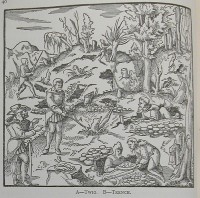1Again, between Septentrio (north wind) and the Subsolanus (east wind), the
first to the right of Septentrio (north wind) is Gallicus; then Supernas; then
Aquilo, which is the middle one of these five; next comes Boreas; and
lastly Carbas, to the left of Subsolanus (east wind). Here again, those who
do not consider the winds to be in so great a multitude, but say there are
but twelve winds in all, or at the most fourteen, assert that the wind called
 20[Figure 20]
20[Figure 20]
by the Greeks Βορέας and the Latins Aquílo is one and the same. For our
purpose it is not only useful to adopt this large number of winds, but even
to double it, as the German sailors do. They always reckon that between
each two there is one in the centre taken from both. By this method we
first to the right of Septentrio (north wind) is Gallicus; then Supernas; then
Aquilo, which is the middle one of these five; next comes Boreas; and
lastly Carbas, to the left of Subsolanus (east wind). Here again, those who
do not consider the winds to be in so great a multitude, but say there are
but twelve winds in all, or at the most fourteen, assert that the wind called
by the Greeks Βορέας and the Latins Aquílo is one and the same. For our
purpose it is not only useful to adopt this large number of winds, but even
to double it, as the German sailors do. They always reckon that between
each two there is one in the centre taken from both. By this method we

 zoom in
zoom in
 zoom out
zoom out
 zoom area
zoom area
 full page
full page
 page width
page width
 set mark
set mark
 remove mark
remove mark
 get reference
get reference
 digilib
digilib